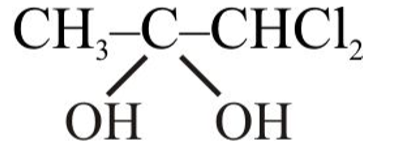Identify A, B and C :
2 - propanol SOCI2−−−→AMg−−→BH2O−−→C
To solve the problem, we need to identify the compounds A, B, and C in the given reaction sequence starting from 2-propanol.
1. Identify the starting compound (2-propanol):
- The molecular formula for 2-propanol is C3H8O or structurally, it can be represented as CH3CH(OH)CH3.
2. Reaction with thionyl chloride (SOCl₂):
- When 2-propanol reacts with thionyl chloride, the hydroxyl group (-OH) is replaced by a chlorine atom (-Cl). This is a substitution reaction.
- The product formed is 2-chloropropane (compound A).
- The reaction can be summarized as:
2-propanol+SOCl2→A (2-chloropropane)+SO2+HCl
- Thus, A=C3H7Cl (2-chloropropane).
3. Formation of Grignard reagent (B):
- The next step involves reacting compound A (2-chloropropane) with magnesium (Mg). This reaction forms a Grignard reagent.
- The Grignard reagent formed from 2-chloropropane is 2-propylmagnesium chloride (compound B).
- The reaction can be summarized as:
A (2-chloropropane)+Mg→B (2-propylmagnesium chloride)
- Thus, B=C3H7MgCl.
4. Hydrolysis of Grignard reagent (C):
- The final step involves hydrolysis of the Grignard reagent (B) with water (H₂O). During hydrolysis, the Grignard reagent reacts with water to form an alcohol.
- The product formed is 2-propanol (compound C).
- The reaction can be summarized as:
B (2-propylmagnesium chloride)+H2O→C (2-propanol)+Mg(OH)Cl
- Thus, C=C3H8O (2-propanol).
Summary of Identified Compounds:
- A=C3H7Cl (2-chloropropane)
- B=C3H7MgCl (2-propylmagnesium chloride)
- C=C3H8O (2-propanol)
- The molecular formula for 2-propanol is C3H8O or structurally, it can be represented as CH3CH(OH)CH3.
- When 2-propanol reacts with thionyl chloride, the hydroxyl group (-OH) is replaced by a chlorine atom (-Cl). This is a substitution reaction.
- The product formed is 2-chloropropane (compound A).
- The reaction can be summarized as:
2-propanol+SOCl2→A (2-chloropropane)+SO2+HCl
- Thus, A=C3H7Cl (2-chloropropane).
- The next step involves reacting compound A (2-chloropropane) with magnesium (Mg). This reaction forms a Grignard reagent.
- The Grignard reagent formed from 2-chloropropane is 2-propylmagnesium chloride (compound B).
- The reaction can be summarized as:
A (2-chloropropane)+Mg→B (2-propylmagnesium chloride)
- Thus, B=C3H7MgCl.
- The final step involves hydrolysis of the Grignard reagent (B) with water (H₂O). During hydrolysis, the Grignard reagent reacts with water to form an alcohol.
- The product formed is 2-propanol (compound C).
- The reaction can be summarized as:
B (2-propylmagnesium chloride)+H2O→C (2-propanol)+Mg(OH)Cl
- Thus, C=C3H8O (2-propanol).
- A=C3H7Cl (2-chloropropane)
- B=C3H7MgCl (2-propylmagnesium chloride)
- C=C3H8O (2-propanol)
Topper's Solved these Questions
- BOOK - CBSE COMPLEMENTARY MATERIALCHAPTER - HALOALKANES AND HALOARENESEXERCISE - LONG ANSWER TYPE QUESTIONS (5 Marks)5videos
HALOALKANES AND HALOARENES
- BOOK - CBSE COMPLEMENTARY MATERIALCHAPTER - HALOALKANES AND HALOARENESEXERCISE - CONCEPTUAL QUESTIONS10videos
HALOALKANES AND HALOARENES
- BOOK - CBSE COMPLEMENTARY MATERIALCHAPTER - HALOALKANES AND HALOARENESEXERCISE - SHORT ANSWER-I TYPE QUESTIONS (2 Marks)18videos
HALOALKANES AND HALOARENES
- BOOK - CBSE COMPLEMENTARY MATERIALCHAPTER - GENERAL PRINCIPLES AND PROCESSES OF ISOLATION OF ELEMENTSEXERCISE - Short Answer-II Type Questions5videos
GENERAL PRINCIPLES AND PROCESSES OF ISOLATION OF ELEMENTS
- BOOK - CBSE COMPLEMENTARY MATERIALCHAPTER - P-BLOCK ELEMENTSEXERCISE - LONG ANSWER TYPE QUESTIONS15videos
P-BLOCK ELEMENTS
Similar Questions
Knowledge Check
- Question 1 - Select One
In the following reaction, C is
CH3−CH=CH2HI−−→AKCN−−→BH2∅H+−−−−→CACH3CH2COOHBCH3−CH2−CH3CCH3OHDCH3C∣CH3HCOOH - Question 2 - Select One
CH3CH2OHP+I2−−−→AMg−−→etherBHCHO−−−→CH2O−−→D
The product 'D' is-An-butylalcoholBn-propylalcoholCpropanalDbutanal - Question 3 - Select One
HOCl−−→AHOCl−−→B−H2O−−−→O
Product 'C' is :-ACH3−CH2−CH=OB C
C D
D
Identify A, B, C , -------- in the following.
EtOHPCl5−−→AMg−−→Et2OB1.cyclohexanone−−−−−−−−−→2.H3O+CView SolutionIdentify the end product (C ) in the following sequence :
C2H5−OHSOCl2−−−−−−→pyridineAKCN(alc)−−−−−−→BH2O/H+−−−−−→CView SolutionIdentify the product C in the series :
CH3CNNa/C2H5OH−−−−−−−−→AHNO2−−−→BCr2O2−7/H+−−−−−−−−→CView SolutionCompounds A,B and C in the following reaction sequence are:
C2H5BrAgCN−−−→AH2O+−−−→B+C.View SolutionCH3OHPI3−−→(A)KCN−−→(B)H2∅H−−→(C)
The compound ( C ) isView Solution

